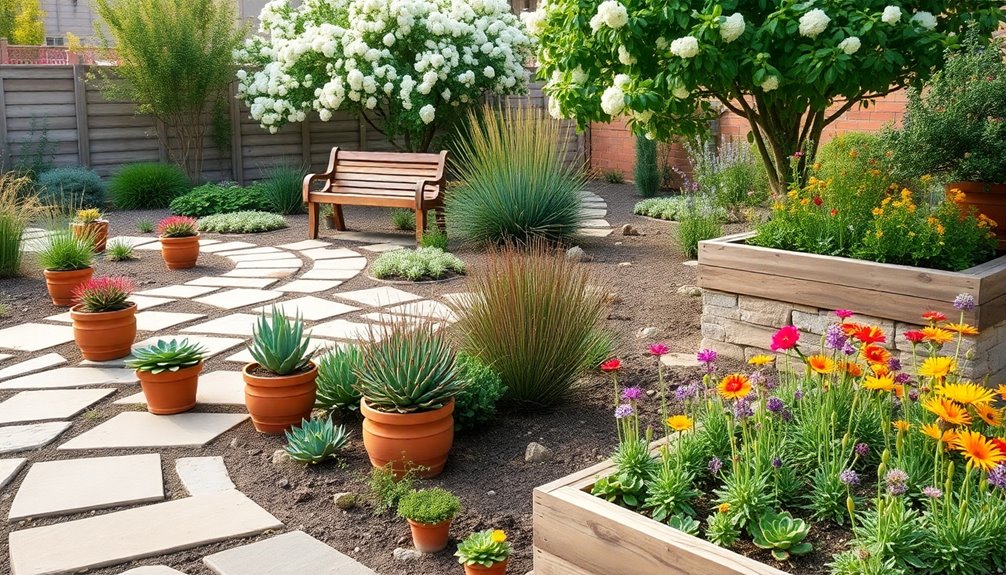Low-maintenance landscaping is essential for senior homes, allowing you to enjoy outdoor spaces without the hassle of extensive upkeep. Consider container and raised-bed gardening to make planting easier on your joints. Choose native and drought-tolerant plants that thrive locally. Xeriscaping cuts down water use, while shade from trees and structures offers comfort. Incorporating safe lighting and accessible pathways guarantees movement is easy. If you want to explore more practical ideas, there are plenty of options to discover!
Key Takeaways
- Incorporate native, drought-tolerant plants to reduce water use and care needs, promoting a sustainable and low-maintenance garden environment.
- Utilize automatic irrigation systems to ensure consistent watering without the need for manual upkeep, making plant care easier for seniors.
- Design raised garden beds for ergonomic access, minimizing bending and kneeling while allowing seniors to enjoy gardening comfortably.
- Implement hardscaping elements like stone paths and patios to provide stable, slip-resistant surfaces, enhancing safety and accessibility outdoors.
- Create shaded seating areas with benches under pergolas to encourage relaxation and social interaction while keeping seniors cool and comfortable.
Why Low-Maintenance Landscaping Matters for Seniors

Low-maintenance landscaping is essential for seniors, as it helps them enjoy their outdoor spaces without the strain of demanding gardening tasks.
By choosing native plants and drought-tolerant species, you can create a beautiful garden that requires minimal care and greatly lowers water usage. This is particularly beneficial if you live in senior homes with water restrictions or want to cut down on utility costs.
Incorporating automatic irrigation systems guarantees your plants receive consistent watering without the hassle of manual upkeep.
Additionally, designing your landscape with hardscaping elements like pathways and raised beds boosts accessibility and safety, reducing fall risks.
Ultimately, a low-maintenance garden not only enhances your outdoor space but also supports your mental well-being, allowing you to relax and enjoy nature.
Container Gardening for Easy Plant Care

Creating a garden that's easy to care for doesn't have to be complicated. Container gardening is perfect for seniors, allowing you to nurture plants without the strain of bending or kneeling.
It offers flexibility and customization for your unique needs. Here are some benefits:
- Ergonomic planting reduces joint strain.
- Easy customization for plant arrangements and soil.
- Mobility lets you optimize sunlight exposure.
- Low-maintenance plants, like Texas Lantana and Zonal Geranium, thrive with minimal care.
With container gardening, you can enjoy vibrant colors year-round while simplifying maintenance tasks.
Plus, self-watering systems can make caring for your plants even easier. Embrace this method, and you'll find gardening more enjoyable and manageable!
Benefits of Raised-Bed Gardening

Raised-bed gardening makes it easier for you to access your plants without the strain of bending or kneeling, which is a huge plus if you have mobility challenges.
You get to control the soil quality and drainage, ensuring your plants thrive while minimizing the upkeep.
This method not only enhances your gardening experience but also makes it more enjoyable and manageable.
Ergonomic Access Benefits
When you incorporate raised-bed gardening into your landscape, you greatly enhance ergonomic access for seniors. These elevated garden beds reduce the need for bending or kneeling, making gardening more accessible and enjoyable.
Here are some key benefits:
- Elevated height promotes comfort and reduces strain on joints.
- Customizable sizes and shapes fit various spaces and abilities.
- Materials like composite wood or stone require minimal upkeep.
- Visually appealing layouts encourage engagement without physical stress.
With raised beds, you create a garden that's not only beautiful but also functional. Educational toys like the Montessori Busy Book can enhance fine motor skills, making gardening tasks easier for seniors.
This approach allows seniors to connect with nature while minimizing physical challenges, ensuring that gardening remains a rewarding activity for them. By incorporating raised beds and ergonomic tools, caregivers can facilitate a more enjoyable gardening experience for elderly individuals. Furthermore, sharing accessible gardening tips for seniors can empower them to cultivate their personal green spaces without feeling overwhelmed. Ultimately, these adaptations can help foster a sense of independence and accomplishment, helping seniors thrive in their outdoor environments.
Improved Soil Control
With the ergonomic advantages of raised-bed gardening established, it's important to recognize how this method also enhances soil control.
Raised beds give you better control over soil quality and drainage, resulting in healthier plants and improved garden productivity. By elevating the soil, you can minimize compaction, allowing roots to grow more freely and access essential nutrients.
Additionally, the structure of raised beds helps retain heat, which can be a game-changer in cooler local climates, extending your growing season.
You can customize your raised beds using materials like wood or stone, ensuring they fit your aesthetic preferences while providing these practical benefits.
Embracing raised-bed gardening means you'll enjoy not only beauty but also effective soil management.
Selecting Native Plants for Minimal Upkeep

When you choose native plants for your landscaping, you're opting for lower maintenance and vibrant beauty.
These plants thrive in your local climate, needing less water and care while attracting beneficial wildlife.
Let's explore the best native plant options and some planting tips to keep your garden thriving with minimal effort.
Benefits of Native Plants
Selecting native plants for your garden not only simplifies maintenance but also enhances the beauty of your landscape. By choosing native species, you can enjoy a variety of benefits that make gardening easier and more rewarding:
- They're well-adapted to local climates, requiring less water.
- Many are drought-tolerant plants, thriving with minimal care.
- Native plants are resilient to pests and diseases, reducing chemical treatments.
- They attract local wildlife and pollinators, supporting the ecosystem.
With their low maintenance requirements, you'll spend less time worrying about upkeep and more time enjoying your garden.
Plus, native plants often lower landscaping costs over time, providing long-lasting beauty while being gentle on your budget and the environment.
Top Native Plant Choices
Choosing native plants not only simplifies gardening but also provides vibrant beauty to your landscape. These plants are well-suited to local climates, making them resilient and requiring less water and fertilizer, which is perfect for a low-maintenance landscape.
In Texas, consider adding drought-tolerant options like Black-eyed Susan, Englemann's Daisy, and Texas Purple Sage. These not only thrive in various conditions but also attract local wildlife. For year-round color, try the Winecup and Desert Willow.
Selecting native plants like the Texas Redbud and Crape Myrtle not only reduces upkeep but also supports local ecosystems, promoting biodiversity. By incorporating these environmentally friendly choices, you can enjoy a beautiful garden with lower costs and minimal need for chemicals.
Planting and Maintenance Tips
To guarantee a thriving garden that requires minimal upkeep, focus on selecting hardy native plants that naturally adapt to your local environment.
By choosing these resilient species, you'll enjoy a beautiful landscape with less effort. Here are some tips to take into account:
- Opt for drought-tolerant native plants like Desert Willow or Firebush to minimize irrigation needs.
- Incorporate species such as Black-eyed Susan or Texas Purple Sage, which attract beneficial pollinators.
- Choose disease-resistant native varieties to reduce the need for chemical treatments.
- Select vibrant options like Texas Redbud or Crape Myrtle for colorful blooms without extensive care.
Additionally, consider implementing water conservation techniques to further enhance the sustainability of your landscape.
With these strategies, you'll achieve a stunning, low-maintenance landscaping design perfect for senior homes.
Xeriscaping: Water-Wise Landscaping Solutions

While traditional gardens often demand constant attention and resources, xeriscaping offers a practical and beautiful alternative for senior homes. By focusing on drought-resistant plants native to your area, you can greatly reduce watering needs and maintenance efforts.
Xeriscaped gardens not only cut water bills by up to 70% but also create visually appealing landscapes using stones, gravel, and ornamental grasses. These low-maintenance landscaping ideas enhance biodiversity, providing habitats for local wildlife while thriving in harsh conditions.
Implementing xeriscaping can even increase your property value, all while promoting sustainable gardening practices. Embrace this eco-friendly approach, and enjoy a stunning garden that requires less work and conserves precious water resources. Additionally, xeriscaping aligns with heat pump efficiency, contributing to a more sustainable environment by reducing overall resource consumption.
Hardscaping for Structure and Functionality

When you incorporate hardscaping into your landscaping design, you're not just adding beauty; you're also enhancing safety and functionality for seniors.
Hardscaping elements create stable, slip-resistant surfaces, making outdoor spaces more accessible. Here are some key features to evaluate:
- Stone paths and patios provide reliable footing and reduce fall risks.
- Raised planters allow for comfortable gardening without bending or kneeling.
- Permeable pavers manage stormwater runoff while requiring minimal maintenance.
- Benches and seating areas promote relaxation and encourage social interaction.
Using durable materials like composite wood and natural stone minimizes ongoing maintenance, ensuring your landscape remains functional and inviting. Additionally, incorporating fire safety regulations into your outdoor design can further enhance the safety of your landscape for seniors.
Choosing Hardy, Low-Maintenance Plants

Hardscaping lays a solid foundation for outdoor spaces, but choosing the right plants can elevate your landscape to new heights of beauty and ease.
Opt for low-maintenance plants like native species, such as lavender and coneflower. These plants thrive in local conditions, requiring less water and care while promoting a healthier ecosystem.
Incorporating hardy perennials guarantees consistent color throughout the seasons and reduces the need for frequent replanting.
Additionally, consider disease-resistant plants like magnolias and grevilleas to minimize gardening challenges. Not only do these selections enhance your landscape's resilience, but they also attract beneficial pollinators, enriching biodiversity.
The Importance of Mulching

Mulching is a simple yet effective way to enhance your garden's health and appearance.
By retaining moisture and suppressing weeds, it reduces the amount of time you spend on maintenance.
Plus, as organic materials break down, they enrich the soil, promoting vibrant plant growth with minimal effort.
Moisture Retention Benefits
To maintain a vibrant garden without the hassle, consider the moisture retention benefits of mulching. A thick layer of organic mulch (2 to 4 inches) works wonders for your plants and reduces the need for frequent watering.
Here's how it helps:
- Retains soil moisture by minimizing evaporation.
- Enhances soil quality as it decomposes, providing essential nutrients.
- Regulates soil temperature, protecting roots from extreme weather.
- Prevents erosion and compaction, improving water infiltration.
With these benefits, mulching not only supports peak plant health but also makes gardening easier for seniors like you.
You'll spend less time worrying about watering and more time enjoying a lush, thriving landscape. Embrace mulching for a low-maintenance garden that flourishes year-round!
Weed Suppression Techniques
While maintaining a beautiful garden can feel overwhelming, employing effective weed suppression techniques can greatly ease your workload.
One of the best methods is using mulch, which should be applied in a thick layer of 2 to 4 inches. This blocks sunlight from reaching weed seeds, considerably reducing weed growth and the need for frequent weeding.
Mulch also retains soil moisture, making your landscaping even more low-maintenance by decreasing watering frequency. Additionally, organic mulches like wood chips or straw enrich the soil as they break down, providing essential nutrients to your plants. Furthermore, incorporating self-watering planters can further simplify garden maintenance by ensuring consistent moisture levels.
Soil Enrichment Properties
One of the simplest ways to enhance your garden's health is through mulching, which offers significant soil enrichment properties.
By using organic mulches, you can improve soil fertility while enjoying less maintenance. Here's how mulching benefits your garden:
- Retains moisture, reducing watering frequency.
- Suppresses weeds, allowing you to focus on enjoyment.
- Regulates soil temperature for plant stability.
- Enhances aesthetics, making your space more inviting.
A thick layer of mulch not only enriches the soil as it decomposes but also minimizes stress for you as a gardener.
With these advantages, mulching becomes an essential practice that brings life to your garden while allowing you to savor its beauty without the burden of extensive upkeep.
Automatic Irrigation Systems for Convenience

Automatic irrigation systems offer a practical solution for seniors looking to maintain their gardens with minimal effort.
These systems, like drip irrigation and soaker hoses, deliver water directly to plant roots, ensuring less maintenance and reducing the risk of overwatering. You can program timers to optimize watering schedules, providing consistent moisture while conserving water resources.
By switching to automatic systems, you could save up to 50% on water bills compared to traditional methods, making it a cost-effective choice.
Many modern systems allow you to control watering through smartphone apps, adding convenience and flexibility for managing your garden remotely.
With minimal manual intervention required, these systems make gardening more accessible and enjoyable for elderly homeowners.
Low-Maintenance Ground Covers

If you're seeking an easier way to enhance your landscape, low-maintenance ground covers can be a game changer.
These plants not only create a beautiful landscape but also require less water and care, making them perfect for seniors.
Consider these options:
- Creeping thyme: Adds color and fragrance while being drought-tolerant and foot traffic-resistant.
- Clover: Remains green year-round, is soft underfoot, and reduces fertilizer needs.
- Sedum: Thrives in poor soil, needing minimal upkeep.
- Ajuga: Offers vibrant foliage and flowers, spreading quickly to fill empty spaces.
Creating Relaxing Outdoor Spaces

After establishing a foundation with low-maintenance ground covers, it's time to think about how to create inviting outdoor spaces that promote relaxation and social interaction.
Start by incorporating comfortable seating options like benches and lounge chairs, providing perfect spots for seniors to unwind or chat with friends. Use low-maintenance plants to enhance the beauty of the area while minimizing upkeep.
Design distinct zones within your garden, such as quiet corners for contemplation and spaces for games or gatherings, encouraging exploration.
You might also consider adding pathways or water features to create a serene atmosphere. These elements will transform your outdoor areas into truly relaxing outdoor spaces, fostering community and a sense of peace. Additionally, incorporating automated contributions can ensure that funds are available for future enhancements of these relaxing spaces.
Adding Shade for Comfort

Adding shade is essential for comfort in your outdoor spaces.
By strategically planting trees and incorporating structures like pergolas or pavilions, you can create cool, inviting areas perfect for relaxation.
Don't forget portable options like shade sails to enhance your patio or seating arrangements whenever you need it!
Strategic Tree Placement
While enjoying the outdoors is essential for seniors' well-being, strategic tree placement can make it even more pleasant. By carefully selecting and positioning trees, you can create a comfortable environment that offers essential shade.
Consider these benefits:
- Protects against sunburn and heat-related illnesses
- Lowers surrounding temperatures by up to 10 degrees Fahrenheit
- Reduces glare, improving visibility and safety
- Enhances property value by up to 15%
Trees like the Texas Redbud and Crape Myrtle not only provide shade but also add visual appeal with their vibrant blooms.
With strategic tree placement, you'll guarantee a safe, cool space for outdoor activities, enhancing your quality of life while boosting your home's property value.
Pergolas and Pavilions
Strategic tree placement lays a solid foundation for outdoor comfort, but incorporating pergolas and pavilions takes shade to the next level. These structures provide essential coverage in your outdoor space, protecting you from sunburn and heat-related illnesses. You can customize them with climbing plants or fabric canopies to enhance aesthetics while minimizing direct sun exposure. Additionally, creative design can transform these structures into stunning focal points in your garden.
| Feature | Benefit |
|---|---|
| Pergolas | Adds charm with minimal care |
| Pavilions | Provides ample seating |
| Cooling Options | Improves airflow and comfort |
Shade Sail Options
Creating a comfortable outdoor environment for seniors is essential, and shade sails are an excellent solution for achieving that.
These low-maintenance fabric structures provide protection from UV rays and can transform your outdoor living space into a serene retreat.
Here are some benefits of shade sails:
- Customizable: Available in various shapes and sizes to fit your unique layout.
- Durable: Made from weather-resistant materials for long-lasting coverage.
- Temperature Reduction: Can lower temperatures in shaded areas by up to 30%.
- Versatile Installation: Easily mounted on existing structures or installed with poles.
Safe Lighting Solutions for Outdoor Areas

When it comes to enhancing safety in outdoor areas, effective lighting solutions are essential for seniors. Installing motion sensor lighting helps illuminate pathways and entry points automatically, reducing trip hazards. Bright LED lights offer energy efficiency and a longer lifespan, ensuring consistent illumination. Place pathway lights at regular intervals to create a well-lit environment that guides movement. Additionally, incorporating true HEPA filters in air purifiers can further improve indoor air quality, making the home environment safer and more comfortable for seniors.
| Type of Light | Benefits | Maintenance Level |
|---|---|---|
| Motion Sensor Lights | Automatic illumination | Minimal maintenance |
| LED Lights | Energy-efficient, long-lasting | Low maintenance |
| Solar-Powered Lights | No electricity costs | Minimal maintenance |
| Warm-Colored Lighting | Improved visibility and calmness | Low maintenance |
| Regular Pathway Lights | Safety and guidance | Minimal maintenance |
These safe lighting solutions enhance visibility while being easy to maintain.
Designing Accessible Pathways and Ramps

Designing accessible pathways and ramps is essential for guaranteeing seniors can navigate outdoor spaces safely and comfortably. This involves ensuring that surfaces are even and free of obstructions, while also incorporating gentle slopes and handrails where necessary. Community planners and architects should prioritize these features to promote independence and mobility among elderly individuals. By following safe outdoor walkway tips for seniors, we can create environments that not only enhance their security but also encourage them to remain active and engaged in their communities.
Here are some key considerations to keep in mind:
- Guarantee pathways are at least 36 inches wide for easy passage with mobility devices.
- Use non-slip materials and textured surfaces to enhance safety and reduce fall risks.
- Construct ramps with a gentle slope, ideally a 1:12 ratio, for easier navigation.
- Install handrails on both sides of ramps and walkways to provide support and stability.
Incorporating Seating Areas for Enjoyment

Incorporating seating areas into your landscape not only enhances the aesthetic appeal but also fosters a sense of community among seniors. By adding benches and patio furniture, you encourage social interaction and provide comfortable spots for resting and enjoying the garden.
Position these seating areas under shade-providing structures like pergolas or large trees to protect against sun exposure. Opt for weather-resistant materials like composite wood or metal to keep maintenance low.
Guarantee that your seating is connected by accessible pathways, making it easy for seniors to navigate and enjoy different parts of the landscape. Arranging seating in clusters promotes conversation and social gatherings, creating inviting spaces for family and friends to share precious time outdoors. Additionally, consider incorporating native plants which can provide beauty and require less maintenance, enhancing the overall landscape.
Frequently Asked Questions
What Is the Most Low Maintenance Landscaping?
When you think about low-maintenance landscaping, consider using drought-resistant native plants that thrive in your area.
Hardscaping features, like gravel paths or patios, can reduce lawn upkeep while adding aesthetic value. You might also want to install an automatic irrigation system to keep your plants watered without hassle.
Ground covers like creeping thyme can replace traditional lawns, minimizing mowing.
Finally, container gardening allows you to easily move plants and adjust to light and access needs.
What Is the Rule of 3 in Landscaping?
The Rule of 3 in landscaping focuses on grouping plants or elements in threes, creating a visually appealing and balanced design.
This principle simplifies your plant selection, helping you choose varieties that complement each other in color, texture, and height.
By using threes, you can establish focal points that draw the eye and enhance the rhythm of your garden.
It promotes harmony, making your outdoor space more inviting and cohesive.
What Is the Best Low Maintenance Garden for the Elderly?
When considering the best low-maintenance garden for the elderly, you'll want to focus on hardy, drought-tolerant plants that require minimal care.
Think about creating raised garden beds to make planting easier without bending. Incorporating stone paths helps reduce lawn upkeep and provides safe walking spaces.
Adding automatic irrigation systems can also simplify watering.
Finally, don't forget shaded seating areas where you can relax and enjoy your garden without much effort.
What Is the Cheapest Option for Landscaping?
When it comes to landscaping, you can't go wrong with native plants. They thrive in local conditions, so you'll save on water and maintenance costs over time.
Incorporating hardscaping elements like gravel or mulch can also lighten your wallet, as they require minimal upkeep.
Plus, consider container gardening, which lets you recycle materials and avoids extensive soil prep.
Conclusion
In the garden of life, low-maintenance landscaping is the gentle breeze that brings ease to our golden years. By choosing simple, thoughtful designs, you're planting seeds of joy that bloom without burden. Picture yourself sipping tea under a shade tree, pathways guiding your steps like a friendly companion. These ideas aren't just plants; they're the embrace of nature, welcoming you to enjoy every moment without the weight of upkeep. Cultivate your oasis and let tranquility flourish.









